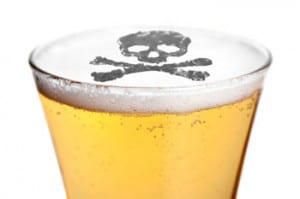 Australia continually struggles with the adverse effects of alcohol on its population. Heavy drinking takes an enormous toll on human health and relationships, and that toll is just as heavy in the workplace. The Australian Drug Foundation estimates that absenteeism due to alcohol use costs employers approximately $1.2 billion annually but also believes the number is low because many workplace costs are hidden or underreported.1 The high rate of alcohol use in worker personal lives makes it more difficult for employers to deal with the issue of alcohol use in the workplace, making random drug and alcohol testing a crucial strategy for maintaining safe worksites. The fact is the adverse effects of alcohol abuse on society are the same adverse effects employers must contend with on a daily basis. In turn, employer efforts to maintain substance free workplaces benefits society as a whole. The reality is that workplace alcohol testing serves a much larger purpose than just detecting alcohol use because it serves as a starting point for addressing a growing Australian problem.
Australia continually struggles with the adverse effects of alcohol on its population. Heavy drinking takes an enormous toll on human health and relationships, and that toll is just as heavy in the workplace. The Australian Drug Foundation estimates that absenteeism due to alcohol use costs employers approximately $1.2 billion annually but also believes the number is low because many workplace costs are hidden or underreported.1 The high rate of alcohol use in worker personal lives makes it more difficult for employers to deal with the issue of alcohol use in the workplace, making random drug and alcohol testing a crucial strategy for maintaining safe worksites. The fact is the adverse effects of alcohol abuse on society are the same adverse effects employers must contend with on a daily basis. In turn, employer efforts to maintain substance free workplaces benefits society as a whole. The reality is that workplace alcohol testing serves a much larger purpose than just detecting alcohol use because it serves as a starting point for addressing a growing Australian problem.
Society’s Window into Alcohol-Related Issues
The incredible problems alcohol use brings Australian society are duplicated in the workplace. Savvy employers stay abreast of the adverse effects reported by government agencies, law enforcement personnel, and treatment specialists because they offer a window into what could happen in the workplace. For example, alcohol plays a large role in the creating numerous health problems, like cardiovascular disease and diabetes. Alcohol can also trigger mental health problems or worsen conditions like anxiety.2 Employees developing these diseases increase health premiums and cost employers in terms of higher rates of absenteeism and lost productivity. They are more likely to experience higher stress levels and make poor decisions in the workplace.
There is a litany of harms that alcohol causes, and those same harms occur in the workplace. People who drink to excess are more likely to act with abandon which means acting irrationally, unpredictably, and possibly violently. Random acts of violence in society include child mistreatment and violent episodes. In the workplace, the random acts are directed at coworkers and supervisors. The violence and physical injuries that frequently accompanies drunkenness is forcing the public to push legislators to adopt wider government action. AMA president Dr. Steve Hambleton discussed the need for more attention to be directed on Australia’s issue of alcohol and violence. He points out that Monday, Tuesday, and Wednesday are the days when physicians spend considerable time helping people who have broken facial bones and broken noses as a result of a “coward punch” (hitting an unsuspecting person). He also mentions the deaths and brain damage that are attributed to the alcohol-fuelled violence.3
Employers must also deal with violence in the workplace when workers drink. Belligerent employees commonly threaten coworkers and supervisors with violence, and some follow through. Alcohol is also responsible for workplace injuries, some permanently disabling, and deaths. Alcohol plays a bigger role in fatal road crashes than road conditions, speeding, or fatigue. Drinking while driving accounts for more than one-third of Australia’s road fatalities.4 A business without a drug and alcohol policy, or one that fails to randomly test employees, will likely have to assume more legal liability than it would otherwise should an employee cause a vehicle accident whilst under the influence of alcohol.
Greater Understanding of Consequences
The impact that alcohol takes on human lives cannot be overstated. Employers can look outward to society and the efforts to address its alcohol-related problems and then look inward with greater understanding and knowledge. Waiting until something tragic happens in the workplace to substantiate the need for a substance free workplace is simply not good policy. Zero tolerance policies and random drug and alcohol testing programs anticipate what could happen if employees use substances in the workplace.
Mediscreen (mediscreen.net.au) offers onsite drug and alcohol screening services with proven quality through application at hundreds of Australian worksites. State-of-the-art mobile van services are also available for employers wishing to conduct unannounced and regular drug and alcohol testing in a cost effective manner.
References
- ADF. (2013, July 8). Drug and alcohol cost to workplaces. Retrieved January 19, 2014, from Australian Drug Foundation: http://bit.ly/1aCjoLX
- NAAA. (2013). National Alcohol Policy Scorecard. Retrieved January 19, 2014, from National Alliance for Action on Alcohol: http://bit.ly/1bBpNoY
- Bianca Hall. (2014, January 19). Greens push for alcohol abuse inquiry gets Australian Medical Association support. Retrieved January 19, 2014, from The Sydney Morning Herald : http://bit.ly/1g9rVUL
- NAAA, National Alcohol Policy Scorecard


